


 , Massimo Menenti1,2, Li Xin3,4, Birendra Bajracharya5, Joni Kujansuu6, Narantuya Davaa7, Liu Shiyin8, Gao Yongqi9,10, Cheng Bin11, Wu Tonghua3, Li Zhijun12, Che Tao3,4, Juha Lemmetyinen11, Liu Jianbo1, Xie Hongjie13, Ran Youhua3, Ruan Zhixing1, Zhao Tianjie1
, Massimo Menenti1,2, Li Xin3,4, Birendra Bajracharya5, Joni Kujansuu6, Narantuya Davaa7, Liu Shiyin8, Gao Yongqi9,10, Cheng Bin11, Wu Tonghua3, Li Zhijun12, Che Tao3,4, Juha Lemmetyinen11, Liu Jianbo1, Xie Hongjie13, Ran Youhua3, Ruan Zhixing1, Zhao Tianjie1
2. Delft University of Technology, Delft 2600 AA;
3. Northwest Institute of Eco-environment and Resources, Chinese Academy of Sciences, Lanzhou 730000;
4. CAS Center for Excellence in Tibetan Plateau Earth Sciences, Beijing 100101;
5. International Centre for Integrated Mountain Development(ICIMOD), Kathmandu G. P. O. Box 3226;
6. Pan-Eurasian Experiment(PEEX), University of Helsinki, Helsinki(33)00014;
7. National University of Mongolia, Ulan Bator 210646;
8. Yunnan University, Kunming 650091;
9. Nansen Environmental and Remote Sensing Center, Bergen N-5006;
10. Nansen-Zhu International Research Center, Institute of Atmospheric Physics, Chinese Academy of Sciences, Beijing 100029;
11. Finnish Meteorological Institute, Arctic Research Center, Helsinki FI-00560;
12. State Key Laboratory of Coastal and Offshore Engineering, Dalian University of Technology, Dalian 116024;
13. Laboratory for Remote Sensing and Geoinformatics, University of Texas at San Antonio, San Antonio TX 78249

The Earth's cold regions, mainly including the Arctic, Antarctic, and the High Mountain cold regions–e.g. the Tibetan Plateau, are facing rapid changes in snow and ice duration, extent, and mass, which have multiple impacts on the environment across a range of temporal and spatial scales. Melting of snow and ice in the Polar Oceans and low and mid-latitude highlands may influence global climate, alter ecosystems, and create hazards, posing major challenges to the nature and human activities.
The "Belt and Road" (B&R) Initiative, proposed by Chinese President Xi Jinping in 2013, aims at linking Asia with Europe and Africa, and the countries in between. The B&R Initiative brings together the ancient Silk Road over land and the Economic Belt over the oceans towards sustainable development. In May 2016, the Digital Belt and Road (DBAR) Initiative was proposed to address these challenges and support the sustainable development of infrastructure, agriculture, environment, nature and heritage, urban, water, coast zone through the widespread use of B&R Big Earth Data, which is the Big Data collected from Earth observations.
The proposed, renewed, B&R land Silk Road will cross over land High Mountain Asia and the snowy and icy regions of Northeast Asia, while the Maritime Economic Belt will stretch to the seasonal ice-free area of the Arctic Ocean (Figure 1). The combined impacts of the northern cold regions on global climate may include the opening up of new sea routes, sea level rising, the albedo feedback and decreasing sea ice extent. Changes in the extent, duration, and mass of frozen water in high mountains have multiple and complex impacts on natural environment and human activities, such as on ecosystems, large-scale infrastructure, transportation, growing cities, water supply, hydroelectric power generation, agriculture development, and disaster mitigation. In many parts of the High Mountain and Cold Regions (HiMAC), vulnerability to such changes needs to be reduced by interventions towards adaptation.
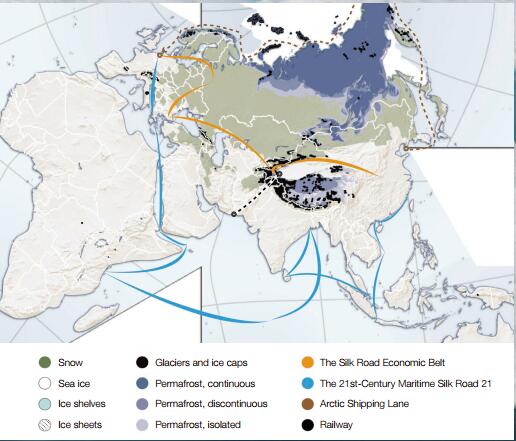
|
| Figure 1 The Belt and Road in High Mountain and Cold Regions (Base Map Courtesy: ESRI and UNEP/GRID-Arendal) |
Along the B&R region, the understanding of these changes has posed big challenges because of remoteness and of sparse observations. To adapt to the changes and ensure regional sustainable development, it is necessary to observe multiple essential variables over a large area. Furthermore, environmental changes in the Earth cold regions cannot be observed and understood in isolation, because of the teleconnections in global climate and socio-economic effects. A better characterization of these changes, understanding the linkages among cold regions would require more accurate, coordinated, and integrated observations, such as ground-, space-based observations and multi-dimensional data collections, for improving the scientific understanding of such remote areas.
The implementation of the Digital Belt and Road Initiative, including the provision of services to users, will require intensive scientific understanding of those changes and a Big Earth Data service. There are gaps in understanding interconnections of low-and high-latitude cold regions, and lack of information services, with multiple capabilities such as fast delivery and large coverage with accurate information. Recently, the fast developing space observations and open data policy in international communities, for example, the ESA Sentinel Series, and Chinese Gaofen Series, and US Landsat open data, provide opportunities for a Big Earth Data information service for HiMAC.
Under the umbrella of DBAR, the Task Force on High Mountain and Cold Regions (HiMAC) was established to address the challenges mentioned above through collaborations with the national and international programs and initiatives. DBAR-HiMAC focuses on science objectives to build a HiMAC Big Earth Data component by linking the existing Earth observations, archiving and documenting Earth observation data and geophysical products, producing knowledge and services.
The HiMAC Big Earth Data service will be promoted to provide information services and support sustainable development through improving risk awareness and enhancing assessments for infrastructure construction (roads, pipelines, and industrial plants), environmental changes, energy supply, disaster reduction, and agriculture development over the high altitude and high latitude B&R regions.
In this paper, a science driven approach is presented to articulate the perspective of DBAR-HiMAC from aspects of observations, scientific understanding, information services, and societal benefits.
Collaboration and Research ProgressIn the past decades, the environment and the ecosystem in Eurasia are undergoing fast changes, especially in the High Mountain Asia and Arctic regions, where the frozen water and its changes are playing a major role, relevant for mitigation of and adaption to climate change. An international consortium took the initiative to pull together and work jointly to foster a more comprehensive perspective on scientific and societal benefits.
DBAR-HiMAC Task ForceThe DBAR-HiMAC Task Force was established in March 2017, with members from China, Finland, Mongolia, Nepal, the Netherlands, Norway, USA, and international programs and organizations, such as the Group on Earth Observations (GEO), and its GEO Cold Regions Initiative (GEOCRI), Pan-Eurasia Experiment (PEEX), International Centre for Integrated Mountain (ICIMOD), and International Society for Digital Earth (ISDE). DBAR-HiMAC is an open and inclusive consortium with the objective of exploring and understanding the changes in HiMAC, to address related science challenges. At the same time, DBAR-HiMAC aims at advocating integrated space and in situ observations to support informed decisions in the lower latitude B&R region and in the Arctic, taking climate teleconnections into account using Big Earth Data.
These goals will be achieved through collaborations and by integrating the DBAR Big Earth Data platform with international systems, such as the Global Earth Observation System of Systems (GEOSS).
Approaches of HiMACThe High Mountain Asia and the northern Eurasia are typical Earth cold regions, including the Qinghai-Tibet and Mongolian Plateaus, Tien Shan and the Altai Mountains. In these regions frozen water plays a critical role in the local environment, with large impacts on transportation, water availability, urban and infrastructure development. These areas also exhibit strong sensitivities to global climate change and highly vulnerable ecosystems. The observation and understanding of these changes are core issues in the B&R implementation.
Such changes have been widely and extensively witnessed in HiMAC, for example, the sea ice extent and thickness have declined in the Arctic Ocean, snow cover has been highly variable, glaciers and ice sheets have experienced negative mass balance and the permafrost changes have been observed in the High Mountain and far north Arctic regions. The following paragraphs detail the current state of related science and observations and summarize key questions and knowledge gaps identified in preparation of the HiMAC Task Force.
Observations and relevant impacts(a) Glacier dynamic changes
There are 83 460 glaciers with a total area of 118 264 km2 in High Mountain Asia (HMA), accounting for 16.3% of the total area of global glaciers except Antarctic and Greenland ice sheets, which fulfill the water needs of a third of a billion people in the region and over billion people living downstream in B&R region. There is also a general consensus that glaciers in this region are retreating and thinning, in some places with concurrent development of glacial lakes, over the past two decades, which has been among the most significant environmental changes in this region.
Although glacier shrinkage has been generally observed since the 1950s in the High Mountain Asia, systematic differences have been noted east to west. Over the past six decades, rates of area change have remained constant in the eastern Himalaya (Racoviteanu et al., 2015). Glaciers in the Hindu Kushi-Himalaya-Karakoram show on average a predominant mass loss. Large, and rapid, advances and retreats occurred in the Karakoram (Hewitt, 2011; Bhambri et al., 2013, Paul 2015); and surging glaciers have been observed in the Pamir, central Tianshan, Karakoram, eastern Kunlun, western Tanggula mountains. Also, glacial lake outburst flood event has increased causing danger to societies in HMA region.
The signature of ongoing and future glacier changes on downstream water resources and ecosystem services in the HKH and Tibetan Plateau region is poorly understood. Moreover, current observations are unable to close the region surface water budget. Characterizing the changes that are taking place in these glaciers and analyzing the threats posed by the changes are challenging tasks made more complex by the difficult terrain and by the lack of in situ observations. With its frequent re-visit and multi-spectral capabilities, space observations are effective and efficient ways to support the intended information services.
Glacier dynamic parameters, such as velocity fields and motion patterns, play a crucial role in the estimation of ice mass balance variations and in the monitoring of glacier-related hazards. However, in situ measurements are hampered by the high altitude and remoteness of the mountain glacial region and the harsh environment. Satellite remote sensing techniques have been used for providing uniform and frequent wide observation of glacier motions using optical and radar images (Figure 2). Space observation could present us with an irreplaceable way to comprehensively and accurately understand glacier dynamics.
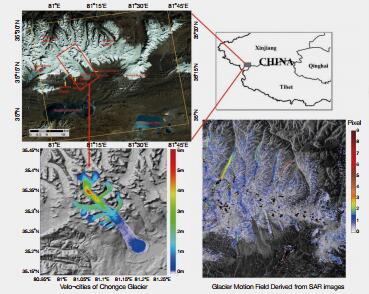
|
| Figure 2 Remote sensing of Glacier Motion detection based on SAR data (Z.X Ruan, etc., 2014; S.Y Yan, 2016) |
(b) Permafrost thawing
Recent investigation shows that permafrost in the HIMAC region being affected by natural or man–made degradation in thickness, areal extent and/or thermal stability. Substantial changes have taken place in recent decades across the high latitude and high altitude regions. The Permafrost in Eurasia, from low latitude Tibetan Plateau to the northern cold regions (Figure 3, left), is a large fraction of global permafrost, and it has been degrading in response to global warming.

|
| Figure 3 Permafrost Distribution in HiMAC (Left, Courtesy: GTN-P) and remote sensing based permafrost stability degradation in the Qinghai-Tibet Plateau (Ran YH et al., 2017) |
These changes resulted in notable impacts on ecosystems, local hydrology and infrastructures, and became more and more important to society and development. Seasonal and yearly variations have been constraining energy and goods flows in Eurasia, thus emphasizing the urgent need for the investments in infrastructures envisaged under the B&R Initiative.
Observations of permafrost are still insufficient, especially in High Mountain Asia and inland Eurasia. Traditional measurements, such as the mean annual ground temperature, thickness of active layer and annual mean air temperature are costly, indirect, and sparse in these regions; while space based Earth observation have the potential to support monitoring of permafrost degradation. For example, remote sensing based methods have been applied to map permafrost thermal stability and to evaluate degradation in the Qinghai-Tibet Plateau (QTP) from 1960s to 2000s (Ran et al., 2017). The results show that the stability degraded in about 154×104 km2, i.e. 88 % of the QTP permafrost area in 1960s. The mean elevation of all permafrost stability classes increase by: 88 m (extremely stable), 97 m (stable), 155 m (sub-stable), 161 m (transitional), 185 m (unstable), and 250 m (extremely unstable). Remote sensing based methods can contribute to DBAR-HiMAC by supporting design of infrastructures, resource development and environmental protection in permafrost regions, and provide high temporal and spatial resolution information on the B&R region.
(c) Snow cover variations
Snow cover, which forms a vital source of freshwater over a large fraction of the northern hemisphere land areas, is currently under stress from climate warming. Mid-and high-latitude air temperatures are currently increasing at a rate above the global average, which enhances changes over the Arctic, subarctic, and other regions influenced by snow cover. This has led to reduction of the extent, duration, and mass (water equivalent) of seasonal snow cover over land in the Northern Hemisphere, which currently exceeds projections from climate models.
The snow covered areas of the Tibetan Plateau are not only valuable as climatological indicators but their melt waters feed rivers (such as the Ganges and Indus) and supplement mountain glaciers and inland lakes, and ultimately affect the ecosystem of the plateau. Recent research evidenced that snow cover area and duration over the Tibet Plateau have been decreasing in winter and spring in the East, while in situ snow depth observations in the North-West shows a slight increasing trend in the last decades. These changes will impact the global climate system and increase vulnerability of snow as a freshwater resource.
Until now, there have been only few measurements of snow cover and snow depth over HMA area due to a sparse observation station network. Satellite-based mapping of snow cover is now used to fill the gaps compiling e.g. daily snow cover (snow extent, SE) and snow water equivalent (SWE) measurements. While the frequent cloud cover and shallow snow over the Tibetan Plateau bring new challenges (bottom panel in Figure 4), novel products include mitigation for some of these effects (Figure 4, Qiu Yubao, 2016). Moreover, the further advent of novel observational capabilities via e.g. the European Copernicus program (Sentinel satellites) and Chinese Fengyun and Gaofen Series, may provide unprecedented possibilities to meet key observational requirements.
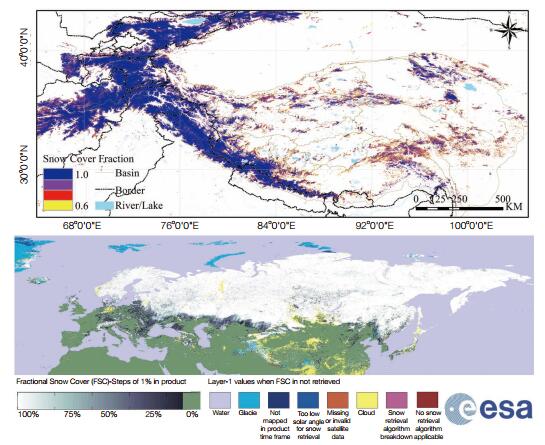
|
| Figure 4 ESA GlobSnow estimate of Eurasia snow cover extent; monthly composite for March 2010 (Bottom, Courtesy: GlobSnow V2.0) and stable snow cover fraction in High Mountain Asia (2015.1.7~2015.1.16) (Top, Qiu YB, 2016) |
Recently, new projects, using the novel sensors, of investigations of snow cover via in situ and remote sensing approaches has been initiated in China to make multi-parameters inventory of snow cover. The exploitation of Copernicus and Chinese Gaofen data requires new approaches to handle Big Earth Data to characterize snow cover in Eurasia, thus contributing to the B&R Initiative.
(d) Lake, river, and sea ice changes
The lake and river ice is a typical essential climate variable that characterizes the northern inland part of China, Mongolia, and Russia in the designed B&R, it also conveys information of high societal relevance, because of the impact of river ice on transportation and navigation along the large rivers of Northern Asia, particularly along the northern border of China, especially the drifting ice is the main factor for the river transportation, even relates to the geopolitical and trans-boundary management and information services for the river in the north border of China.
While, arctic amplification is the fast climate warming in the Arctic, at least twice as fast as the global average in recent decades (Overland et al., 2016). The most dramatic changes in the Arctic climate have been the decrease in the sea ice extent, concentration, thickness, as well as the duration of the ice season in the past decades (e.g. Cavalieri and Parkinson, 2012).
The Arctic sea routes are very relevant to the commercial sea–bound communication between China and Europe, a core aspect of the B&R Initiative (Figure 1). The strong decline of sea ice cover is expected to continue, with estimates of an ice-free Arctic in late summer by 2050 (Overland and Wang, 2013). Less and thinner sea ice allows easier navigation with several shorter routes and other off-shore activities in the Arctic, which increases the need for operational marine and weather forecasts and services for route selection and planning of operations.
The Bohai Sea is the south margin of the sea ice covered region, where the Chinese harbors have been flourishing in the last decades. The combined application of multiple satellite images could help to understand the impacts of sea ice on infrastructure, and provide alert information to support operation and management of this icy harbor region.
The Arctic warming/sea ice reduction may have far-reaching impact on the weather and climate over the Northern Hemisphere (Gao et al., 2015), the loss of sea ice, which reflects much of the energy from sunlight, will increase the rate of global warming. This is believed to have a significant effect on the weather in much of the northern hemisphere including the high mountain and cold regions.
Even though, the hydraulic and oceanographic departments maintain operational site observations for drifting ice and ice flooding alert, and offshore sea ice monitoring, up to date, there are still large gaps in the remote sensing products on lake, river, and sea ice thickness and concentrations, to satisfy operational requirements for navigation and transportation. The use of the high resolution satellites is a valuable approach for the prevention plan for bridge flooding of cross-river railway and highway and bombing of ice plug. Furthermore, improved satellite observations will also benefit the construction of the harbor facilities in the Arctic coastal areas.
(e) Water and energy cycle
Recent research has provided evidence that the emergence of rapid Arctic warming in recent decades has coincided with unusually cold winters over Northern Hemisphere continents. The high latitude cold regions, especially the Arctic Ocean, have a profound influence on the northern hemisphere's weather and climate, which further extends to a global impact. The High Altitude Mountain cold regions, in particular the QinghaiTibet Plateau, contribute to climate variability through the water and energy cycle.
The headwater areas of seven major rivers in Southeast Asia, i.e. Yellow River, Yangtze, Mekong, Salween, Irrawaddy, Brahmaputra, and Ganges, are located in the Tibetan Plateau. Estimates of the Plateau water balance rely on sparse and scarce observations that cannot provide the required accuracy, spatial density and temporal frequency. Fully integrated use of satellite and ground observations is necessary to support water resources management in South and East Asia and to clarify the roles of the interactions between the land surface and the atmosphere over the Tibetan Plateau in the Asian monsoon system (Menenti et al., 2015).
We have used different remote sensing data products to characterize the links between Tibetan glaciers, lakes, and rivers. This result indicates which lakes are expected to be strongly affected by the predicted further shrinkage of the glaciers on the Tibetan Plateau. Geometric links between Tibetan glaciers and lakes in this analysis are expected to assist in understanding the often very local differences in lake level change patterns, and could provide a new way to better constrain local glacial mass balance variations in this climate-sensitive region (Phan et al., 2013, 2014, and 2017).
The priority in the future will be the integration of the different data products towards a better understanding of their quality and of hydrospheric and cryospheric processes. For example, we need to assess the impact of the sub-pixel topographic correction of albedo on the land surface radiative and heat balance. Accordingly, we may need to revisit the assessment of the ET surface energy balance methods and data products. Next, we need to explore the analysis of observed changes in Tibetan glaciers and lakes with the support of the new insights and data products on the surface energy balance (Menenti et al., 2015 and 2016).
(f) Hydro-ecosystem vulnerability
Water is the core variable in natural ecosystems. For example, the Qinghai-Tibet Plateau is not only the headwater areas for the seven major rivers, but also the headwater areas of many inland rivers, such as Shiyang river, Heihe River, Shule River, and Tarim river in Northwestern China. These rivers not only feed tens of millions of people, but also maintain fragile ecosystems along the ancient Silk Road and provide important ecosystem services. Recent research found that the higher warming rate in High Mountain and cold region has a profound influence on the hydro-ecosystem as well as human well-being. The systematic decline of snow cover and glacier retreat and thinning in some places led to the growth of glacial lakes in High Mountain Asia over the past two decades. The degradation of permafrost in High Mountain Asia affects the surface runoff, groundwater recharge, soil erosion, vegetation growth, as well as aquatic environment.
Several comprehensive earth observation experiments have successfully improved the observation and understanding of hydro-ecosystem interaction, such as the Watershed Allied Telemetry Experimental Research (WATER) and Heihe Watershed Allied Telemetry Experimental Research (HiWATER) in Heihe river basin (Li et al., 2009 and 2013). This data and knowledge were used to develop an integrated model of the water-ecosystem-economy. The model provides a scientific basis and tool to manage water resource integrated for watershed sustainable development (Cheng et al., 2014).
(g) Atmosphere components
A significant fraction of cloud condensation nuclei (CCN) in the atmosphere arises from new-particle formation (Kuang et al., 2009; Merikanto et al., 2009) and 35% of these nuclei are directly formed in the free troposphere (Merikanto et al., 2009). While particle nucleation has been observed almost everywhere in the atmosphere (Zhang et al., 2012), the mechanisms governing this process are still poorly understood and subject to ongoing research (Kulmala et al., 2013; Zhang et al., 2012). An important task is to elucidate the factors and underlying mechanisms governing the process at high altitude and in remote areas.
Recently, it has been shown that new-particle formation can take place with high frequency at high altitudes.
However, none of these previous studies has measured the chemical composition of the growing particles. Therefore, while these studies confirm that new-particle formation at high altitude is important, they are insufficient to allow for a reasonable evaluation of the mechanisms in order to improve the accuracy of new-particle formation representation in models. A detailed framework that unifies the particles' physical properties and the vapours' chemical composition is required to understand the fundamental pathway by which nucleation occurs in the atmosphere.
Recently, a study conducted in the Alps and published in Science (Bianchi et al., 2016), have shown new insights into new particle formation taking place in the free troposphere. Expanding such observations in the Asian remote region like the Tibetan plateau would provide extremely valuable information.
Observation networks and data resourcesTo reduce the risk of implementation of B&R, timely and continuous observations are needed to be fully employed for a HiMAC Big Earth Data service. Fully integrated use of satellite and ground observations is necessary. The in situ measurements are valuable to validate and calibrate satellite retrievals and process models over the entire area on a regional scale.
A synergetic network of satellite observations and data resources is an effective way to develop big earth data information services. Depending on the need, various satellite data of Chinese receivers, ESA, NASA, and/or NOAA of different spatial and temporal resolution can help to depict the entire area of interest within B&R. The Chinese Water Cycle Observation Mission (WCOM), which is planned for 2020, is designed to capture simultaneous measurements of key elements of the global water cycle including soil moisture, ocean salinity, snow water equivalent, soil freeze/ thaw. The Geofen series data and Chinese Metrological satellite series can provide high spatial and temporal resolution image data on HiMAC. A network could include different national stations, not only the ground stations, but also the field campaign centers, such as the China Remote Sensing Satellite North Polar Ground Station (CNPGS) (Kiruna, Sweden), the Finnish Meteorological Institute Arctic Research Centre (FIN ARC) Sodankylä, Finnish Lapland, the Chinese Cryosphere Observation Station of China, Heihe Satellite Experiment Station (Heihe, China), while other programs and projects, like GEOCRI, PEEX, relevant EU H2020 projects, Chinese projects, and research activities in ICIMOD, Nepal, Mongolia, Russia, and the center Asia will provide additional and vital data.
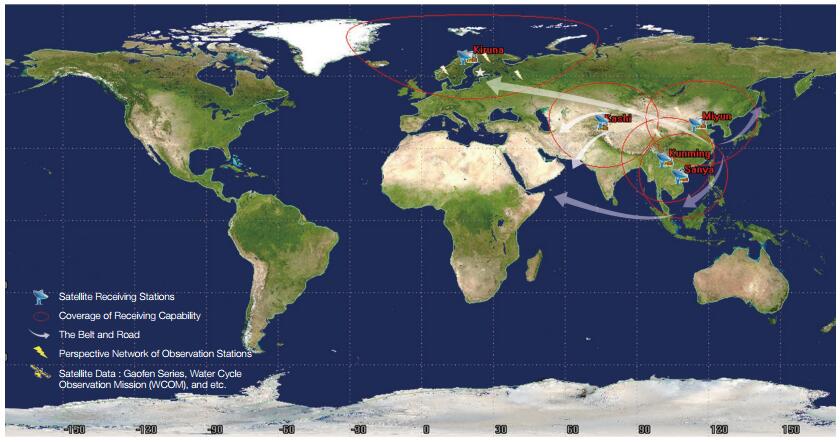
|
| Figure 5 Coverage of satellite receiving stations in HiMAC (Based map courtesy: MODIS) |
In near future, and main tasks and deliverables for DAR-HiMAC are as follows. (1) To build research and observation network of High Mountain and Cold Regions (HiMAC), constructing the International Center of Excellence (ICoE), working with the China Remote Sensing Satellite North Polar Ground Station (CNPGS) and developing the international research excellence; (2) To develop and define Essential Cold Region Variables (ECRV), strengthen the research and development of space observation technology, foster the integration of ground-and space-based observations, develop series of Essential Variable information products for Earth cold regions; (3) To build the HiMAC Big Earth Data platform and archive the HiMAC data through the combination of the spatial observation products, and the existing Earth observation data; (4) To carry out scientific research, focusing on the observations and scientifically understanding of changing snow, frozen soil, river / lake ice, sea ice, mountain glaciers and other environmental changes; (5) To promote capacity building, advance the applications and services of HiMAC-Big Earth Data, providing risk assessment and early warning for infrastructure construction, environmental change, disaster reduction and mitigation in "B&R" high altitude and high latitudes areas, and to carry out high resolution remote sensing monitoring services for port and sea way; (6) To develop an indicator system for the Sustainable Development for the HiMAC region, provide consultant reports for the "B&R" areas and the United Nations Sustainable Development Goals (UN SDGs), build scientific knowledge-bases for HiMAC and provide decision making services.
Viewpoints of Partners Participating in DBAR-HiMAC: Benefits of Big Earth Data to B&RFrom the perspective of observations, scientific understanding, and information services for B&R, the HiMAC Big Earth Data approach will cross fertilize and benefit from/to international partnerships with scientists and stakeholders. The following sections introduce several relevant HiMAC partners and outline approaches for their collaboration within HiMAC.
Pan-Eurasian Experiment

|
| Bianchi Federico, Research Scientist, Helsinki University, Finland |
The Pan-eurasian experiment (PEEX) program is a multi-disciplinary research initiative focused on understanding biosphere-ocean-cryosphere-climate-society interactions and feedbacks, which aims to fill the scientific gaps needed for a holistic understanding of the feedback mechanisms for the Northern Eurasian and its high mountain regions. The PEEX research program focus ranges from sparsely-built environments to heavily-industrialized regions, such as mega-cities, in the B&R region. PEEX operates together with DBAR in an integrative way using tools from natural and social sciences such as in situ and satellite observations, laboratory experiments, multi-scale models and statistical data analyses together with socio-economic analyses. The scientific results from this collaboration will be used for developing global and regional scale climate scenarios, for constructing reliable early-warning systems, and for the mitigation and adaptation planning for the use of B&R Initiative.
Atmospheric composition plays a central role in the Northern Eurasian climate system, with heavy emphasis on Third Pole region. Key compounds in this regard are greenhouse gases and their biogeochemical cycling, ozone, carbon monoxide, numerous organic compounds as well as different types of aerosols and their precursors. At the moment, there is a serious gap in our knowledge on tropospheric composition and chemistry over this region. In situ understanding and model simulations of high mountain clouds are particularly deficient. There is thus a need for harmonized, coordinated, and comprehensive greenhouse gas, trace gas and aerosol in situ observations, for support of DBAR satellite and remote sensing activities.
In the snow-covered parts of Eurasia, long-range transported aerosols containing black carbon and deposited onto snow tend to enhance the spring and early-summer melting of the snow.
PEEX-RI (research infrastructure) aims to fill in the observational gap in atmospheric in situ data for support of ground base remote sensing data in the Northern Eurasia high mountain region. A common information background would be a unified base for PEEX/DBAR modelling platform, for the development of integrated modelling clusters which could combine ecological, economic and social dimensions.
In addition to data services, PEEX/DBAR is developing procedures for integrating and linking natural science and social science knowledge and data. For example, we need to analyze data on emission sources together with population health risk factors, environment pollution, such as air pollution, food security, drinking water quality, etc. in lieu with economic and political goals of B&R Initiative. Via multidisciplinary data interfaces and data procedures we are able to, for example, connect satellite observations with inverse modeling, provide fast updates to emission inventories, estimate the emission for the climate models, and, in the end, provide climate and air quality scenarios and the storylines of the future development of the region.
International Centre for Integrated Mountain Development

|
| Basanta Shrestha, Director Strategic Cooperation, ICIMOD |
The International Centre for Integrated Mountain Development (ICIMOD) is a Kathmandu based regional intergovernmental learning and knowledge centre serving eight member countries in the Hindu Kush Himalaya (HKH). The HKH is the highest mountain range in the world and hosts unique landscapes with rich cultural and biological diversity. The livelihood systems of people in the region are exemplary of adaptation and resilience to the challenges of extreme mountain environments.
The HKH is witnessing the impacts of climate change in various forms, such as accelerated snow melt and glacier retreat, growing glacial lakes and risks of glacial lake outburst floods (GLOFs), and increasing frequency of extreme events followed by natural disasters. The frequency and magnitude of extreme events pose additional threat to infrastructure such as dams, hydropower plants, transmission lines and roads. Changes in land cover and vegetation growth in the rangelands are directly affecting the livelihoods of mountain communities.
Currently, the use of remote sensing on cryosphere applications in the region is limited to assessing the areal extent of snow cover, glaciers and glacial lakes using low and medium resolution satellite images. While there has been some progress in terms of the number of monitoring systems in the region, there is still no institutionalized monitoring of snow cover and permafrost. The scarcity of hydrological observations and challenges in data sharing limit the understanding of the main physical processes that control runoff and snow conditions. ICIMOD, through its Mountain Environment Regional Information System (MENRIS) and Cryosphere programmes, has been working to enhance scientific knowledge on climate, the cryosphere and hydrological changes in the HKH with a combination of earth observations, in situ measurements and modeling.
The DBAR-HiMAC initiative provides a unique opportunity for ICIMOD to contribute to and benefit from international efforts being made in this area. With its intergovernmental and regional mandate, and as a participating member of GEO, ICIMOD is positioned to act as both a facilitator for regional cooperation and a knowledge broker to address much needed mountain focused research and development in the HKH. Regional cooperation and a coordinated data sharing framework from DBAR-HiMAC will not only support scientific research, but also develop of operational products and services which will lead to improved understanding of and responses to the dynamic processes taking place in high mountain environments.
Michigan State University

|
| Qi Jiaguo, Professor, Michigan State University, USA |
The "Belt & Road" or B&R is such a grand strategy to connect China to the rest of the world that is to benefit many nations and affect millions of lives. However, the implementation of such grand strategy relies on a thorough knowledge of physical, cultural, and social conditions along the B&R routes and their associated networks. Critical among information and knowledge are the dynamics of the mountain systems that provide one of the most critical natural resources, freshwater from glaciers and precipitation.
Both long-and short-term spatial-temporal distribution of freshwater and their human uses are fundamentally imperative that could underpin the implementation and sustainability of the B&R grand strategy. This DBAR-HiMAC Task Force presents a one-stop shopping of such critical mountain ecosystems information and knowledge, by laying out the prerequisite observational strategies, technologies, analytical tools and big data science to generate the information and understanding the critical mountain ecosystems within the B&R network.
Not only did the science plan outlined the technical approaches to develop digital B&R observations and information services to the nations and communities with the B&R network, but it also demonstrated the importance of international collaborations through which data information could be jointly collected, enriched, and shared to better serve the scientists and citizens of all B&R nations and communities.
A broad range of readers including scientists and decision-makers alike would find the HiMAC Big Earth Data information sources vitally important for B&R grand strategy implementation and sustainability.
National University of Mongolia

|
| Tsolmon Renchin, Professor, National University of Mongolia, Mongolia |
Accurate data and information are required in implementation of large scale B&R Initiatives. The Initiative embraces vast territory in Eurasian continent, and Mongolia is a part of it. Our lab team is happy to be a counterpart of the DBAR-HiMAC initiative, and ready to put joint effort towards realization of B&R in sustainable way of the development.
Earth observation is of special importance in vast yet sparsely populated with cold continental climate area like Mongolia. EO utilization in Mongolia has got prominent input in the environmental field. Today, EO forecast to warn on adverse weather conditions that are related to natural disasters like drought and zud (local name for severe winter in Mongolia, which has detrimental economic and social impact causing the death of millions of livestock).
Time series satellite data help us to better understand atmospheric phenomena over large areas like those covered by B&R extending from South East Asia to the North Europe. Such information is vital for decision makers to plan and develop future strategy with minimal economic, environmental, social, and cultural loss. There are several research related to EO use in permafrost change, where the research relied only on free coarse resolution data. Glacier studies of the Chinese part of Altai mountain are rather extensive compared to studies in the Mongolian part of Altai Mountain. EO use in glacier study in Mongolia is attributed to various national and international research groups. NOAA, FY2C, and lately MetOp satellite data have been used in glacial studies. Fewer efforts have been made to define snow depth with ALOS/PALSAR data in the West Mongolia.
Indeed, there is an indispensable need for regional level collaboration on global issues related to High Mountains and cold regions in order to support B&R Initiative. Becoming an implementing partner of DBAR-HiMAC will give an opportunity to our scientific community to have access to accurate data, to gain know-how, and share our knowledge and experience, and importantly input in regional/global level data storage system for future reference. Availability of high resolution EO data within DBAR-HiMAC will allow consistent throughout the time research on permafrost, glacier, land cover change, etc. Being a part of DBAR-HiMAC, the NUM-ITC-UNESCO Lab will benefit promoting international collaboration of scientific team, preparing qualitative personnel, strengthening research methods and scientific works, preparing joint publications, and conducting international conference and workshops.
The Lab is highly encouraging to conduct joint research on all above thematic areas relevant to High Mountain, and cold regions, where our students and researchers in collaboration with other national institutes shall contribute to in situ data collection/ measurements, data processing/analyses, modeling, and data storage. Moreover, we support individual Ph.D. research focusing on topics where knowledge and high resolution data sharing are anticipated. Some of the aspects of research consideration may include glacier study over Altai Mountain, Dust storm monitoring over large area covering Central to East Asia. Permafrost and snow related phenomena research with EO technique. Transboundary wildlife monitoring on large areas and studies on invasive species across high mountains are also welcomed research topics.
Nansen Environmental and Remote Sensing Center (NERSC)

|
| Stein Sandven, Coordinator of INTAORS Professor, NERSC, Norway |
Nansen Environmental and Remote Sensing Center is a non-profit research center affiliated with the University of Bergen, with focus on marine and Arctic science, which is now a national environmental research institute and receives basic funding from the Ministry of Climate and Environment through the Research Council of Norway. As a national environmental research institute, the Center has in particular strengthened the expertise within studies of regional climate change research and studies of the oceans and sea ice in the Arctic oceans Research activities include satellite remote sensing, ocean acoustics, and development of information systems where observational data are integrated with models and disseminated to users. Satellite methods and monitoring systems are developed for sea ice, icebergs and other cryospheric and ocean variables. Acoustic methods used are ocean acoustic tomography and passive listening of ambient noise with focus on the Arctic region.
The goal of the research work is to develop observing systems to support operational oceanography and climate research. NERSC develops web-based dissemination systems where users can search, display and download observational data and model results from various geographical areas. The Nansen Center in Norway has established research centers in China, Russia, and India, which can play a role in climate and environmental research in the B&R region. These are:
● Nansen-Zhu International Research Centre, Beijing, China, established in 2003;
● Nansen International Environmental and Remote Sensing Centre, St. Petersburg, Russia, established in 1992;
● Nansen Environmental Research Centre-India, Cochin, India, established in 1999.
Recently, the Nansen Center in Norway is coordinator of the large-scale EU project INTAROS, which is a research and innovation action under the H2020-programme, it will run from 2016 to 2021. INTAROS will develop an integrated Arctic Observation System (iAOS) by institutions in Europe, North America, and Asia. In situ observing systems are much more limited due to logistical constraints and cost limitations, satellite Earth observation (EO) data plays an increasingly important role in such observing systems.
Conclusion and PerspectivesGiven the amount of available historical Earth observation (EO) data, as well as the fast evolution of interpretation methods of satellite observations and various numerical modelling approaches, an international joint research effort targeting the High Mountain and cold regions (HiMAC) in Eurasia became feasible for ensuring better understanding of the changing mechanisms linking the Earth Three Poles and for providing support for the regional development. The Big Earth Data on HiMAC from space promotes scientific discovery in the Earth sciences, especially concerning global changes and a tangible Digital Earth conception, which will eventually provide the information services for the Digital and Belt initiative. While the key challenges are:
● Technology development: Provide an up-to-data observations products and modeling towards sustainable cold regions observation science, which will need more technology development on the integration of in situ and remote sensing observations.
● Scientific understanding: Improve the understanding of the interconnections and teleconnections between high latitude cold regions, especially the Arctic, and High Mountain cold regions.
● Sustainable Development Challenges: High Mountain Asia includes the headwaters of river systems that provide fresh water for nearly one-third of the world's population, and the high latitude warming would provide new opportunities for the B&R implementation.
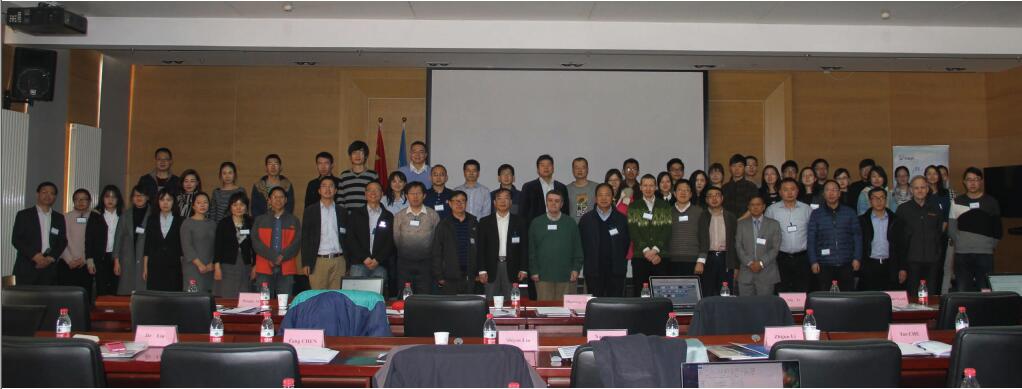
|
| The 2017 International Workshop on Observations and Understanding of Changes in High Mountain and Cold Regions (HiMAC2017) was held in Beijing, China on 3-4th, March, 2017 |